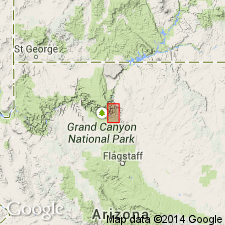
- Usage in publication:
-
- Unkar terrane
- Unkar group*
- Modifications:
-
- Original reference
- Dominant lithology:
-
- Conglomerate
- Limestone
- Sandstone
- Lava
- AAPG geologic province:
-
- Southern Rocky Mountain region
Summary:
Pl. 60, etc. Unkar terrane in Grand Canyon series. Massive beds of reddish magnesium limestone, lava beds, sandstones, limestones, lava, and conglomerate. Thickness 6,830 feet. Underlies Chuar terrane. Lower group of Grand Canyon series. [Unkar group adopted by the USGS. Age is pre-Cambrian.]
Named from outcrops in Unkar Valley, Grand Canyon area, northern AZ.
[GNC remark (ca. 1938, U.S. geologic names lexicon, USGS Bull. 896, p. 2219): Unkar group now divided into (descending) Dox sandstone, Shinumo quartzite, Hakatai shale, Bass limestone, and Hotauta conglomerate.]
Source: U.S. geologic names lexicon (USGS Bull. 896, p. 2219).
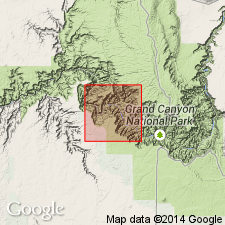
- Usage in publication:
-
- Unkar group*
- Modifications:
-
- Revised
- AAPG geologic province:
-
- Southern Rocky Mountain region
Summary:
Unkar group of Grand Canyon series. Divided into five new formations (ascending): Hotauta conglomerate, 6 feet; Bass limestone, 335 feet; Hakatai shale, 580 feet; Shinumo quartzite, 1,564 feet; and Dox sandstone, 2,297 feet. Unconformably overlies Vishnu schist. Unconformably underlies Tapeats sandstone (new) of Tonto group. Chuar group is absent. Age is pre-Cambrian (Grand Canyon). Report includes geologic map.
Source: Modified from GNU records (USGS DDS-6; Denver GNULEX).
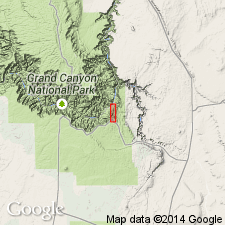
- Usage in publication:
-
- Unkar Group*
- Modifications:
-
- Revised
- AAPG geologic province:
-
- Southern Rocky Mountain region
Summary:
Assigned as the lower group of the Precambrian Grand Canyon Supergroup (new rank; formerly Grand Canyon Series) in the Grand Canyon area of northern AZ in the Southern Rocky Mountain region. Divided into the (ascending): Hotauta Conglomerate, Bass Limestone, Hakatai Shale, Shinumo Quartzite, Dox Sandstone, Cardenas Lavas. Unconformably overlies Vishnu Schist. Unconformably underlies Nankoweap Formation of Grand Canyon Supergroup. The overlying part of the Nankoweap referred to as the upper member. In the graben at Tanner Canyon rapids, the overlying part of the Nankoweap is called the ferruginous member.
Source: GNU records (USGS DDS-6; Denver GNULEX).
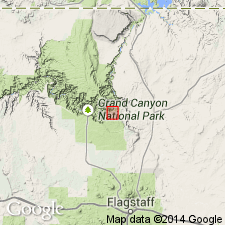
- Usage in publication:
-
- Unkar Group
- Modifications:
-
- Revised
- AAPG geologic province:
-
- Southern Rocky Mountain region
Summary:
Dox Sandstone, middle formation of Unkar Group, Grand Canyon area of northern AZ in the Southern Rocky Mountain region, redescribed as Dox Formation because it consists of siltstone, shale, and minor amount of dolomite and conglomerate as well as sandstone. Dox divided into four newly named members: Escalante Creek (base), Solomon Temple, Comanche Point, and Ochoa Point (top) Members. Depositional environment discussed. Geologic map. Of late Precambrian age.
Source: GNU records (USGS DDS-6; Denver GNULEX).
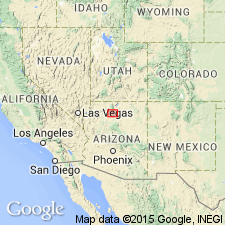
- Usage in publication:
-
- Unkar Group*
- Modifications:
-
- Age modified
- Overview
- AAPG geologic province:
-
- Southern Rocky Mountain region
Summary:
Is the oldest group of the Grand Canyon Supergroup. Lies above the "greatest unconformity" at the top of the Vishnu Schist and unconformably beneath the Nankoweap Formation of the Unkar. Divided into Bass Limestone (base), Hakatai Shale, Shinumo Quartzite, Dox Sandstone, and Cardenas Basalt. Is 1,600 to 2,197 m thick. Consists of rocks of marine, tidal flat, nearshore marine, and continental origin. Four episodes of marine deposition followed by times of emergence and subaerial accumulation recorded. Intrusive and extrusive igneous activity of Grand Canyon Supergroup restricted to Unkar. Such activity preceded Cardenas; mafic sills found in Dox and Bass. Deposition of Unkar began about 1,250 Ma about the end of Belt Supergroup deposition. Age changed from Proterozoic Y to Middle Proterozoic, the age term applied to rocks older than 900 Ma and younger than 1,600 Ma. Used in Grand Canyon area of northern AZ in the Southern Rocky Mountain region.
Source: GNU records (USGS DDS-6; Denver GNULEX).
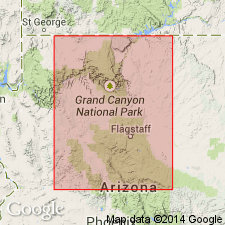
- Usage in publication:
-
- Unkar Group*
- Modifications:
-
- Overview
- AAPG geologic province:
-
- Southern Rocky Mountain region
Summary:
Is the lower group of the Grand Canyon Supergroup in the Grand Canyon region of northern AZ in the Southern Rocky Mountain region. Divided into five formations (ascending): Bass Limestone, Hakatai Shale, Shinumo Quartzite, Dox Sandstone (or Formation), and Cardenas Basalt, and some unnamed diabasic intrusive rocks that occur as dikes and sills within all units below the Cardenas. Sills (olivine diabase) greater than 65 ft thick are confined to the Bass, and Hakatai Dikes intrude all the formations of the Unkar above the thick sills.
Source: GNU records (USGS DDS-6; Denver GNULEX).
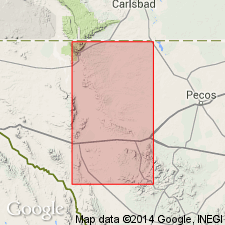
- Usage in publication:
-
- Unkar Group*
- Modifications:
-
- Paleomagnetics
- AAPG geologic province:
-
- Southern Rocky Mountain region
Summary:
Comparison made of paleomagnetic poles and polar paths of Middle Proterozoic rocks of Hazel Formation of Van Horn area, TX (Southwestern Basin-and-Range region) with Middle Proterozoic rocks elsewhere in North America. Changes in direction of apparent polar wander are interpreted to reflect plate interactions and collisions responsible for episodes of deformation on the craton. Folding phases in Van Horn and Adirondack Mountain regions are relatable to 5 direction changes of polar wander between about 1,200 and about 1,000 Ma. Hazel accumulated during an episode of south-to-north thrust faulting that has been identified as belonging to Grenville Orogeny. Hazel is a 1,500 ft thick, moderately to little deformed, purple-red, fine- to coarse-grained sandstone above Allamoore Formation and beneath Carrizo Mountain Group; is similar to Dox Sandstone, Unkar Group, Grand Canyon Supergroup of AZ (Southern Rocky Mountain region) in lithology and in lack of metamorphism. The lower, lower middle, upper parts of Hazel have normal polarity directions. Three poles from Hazel describe a short, north-south trending trace that appears to have rotated about 30 deg clockwise with respect to apex and upper part of descending leg of Unkar loop. A 30 deg counterclockwise vertical-axis rotation brings Hazel into general coincidence with upper part, middle member of Dox, and with middle and early late Keweenawan poles from Lake Superior region.
Source: GNU records (USGS DDS-6; Denver GNULEX).
For more information, please contact Nancy Stamm, Geologic Names Committee Secretary.
Asterisk (*) indicates published by U.S. Geological Survey authors.
"No current usage" (†) implies that a name has been abandoned or has fallen into disuse. Former usage and, if known, replacement name given in parentheses ( ).
Slash (/) indicates name conflicts with nomenclatural guidelines (CSN, 1933; ACSN, 1961, 1970; NACSN, 1983, 2005, 2021). May be explained within brackets ([ ]).

